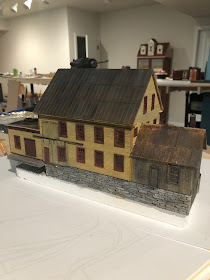I don’t want to admit how long this thing has been sitting “half finished” (started??!!) in the corner of my workbench. It’s basically been a sub-wall shell for about 4 years.
Finally got the thing finished up - next step is to site it and install on a scenery base.
If you want to spend an entertaining half hour, go to You Tube for excepts from a documentary about the mill:
https://youtu.be/l2KJbRHO76s
A rather complete set of information on the prototype building is featured on the LOC web site - this model is a to scale version based on those drawings and photos. Here's one of those -
I’m trying to incorporate some new technique with each model I build. For example, on the last resin boxcar I finished I tried etched metal ladders. In this case it was getting a weathered look to plastic windows, and painting the stonework and brick chimneys using some tips from Geoff Taylor’s book. His brick and stonework are simply the best I’ve ever seen - anywhere. And his techniques seem straightforward - I haven’t mastered them yet but it’s been interesting to try them out.
Although Thresher's Mill certainly existed in the mid 1950s, my model shows it in slightly better repair than the LOC photos and video. Meaning that it reflects the building more or less as it would have appeared in the 1910s-30s - certainly pre-WWII.
I’m enjoying this slightly earlier era modeling. I'm actually working on a blacksmith shop of all things at the moment - just found a couple of vintage photos that made modeling the building seem very appealing to me. No surprise to anyone who's read my blog post on my early model railroad influences.
Who knows, maybe some of this earlier era stuff may well leak off the modeling desk and onto the layout…..














